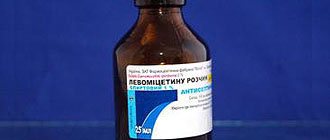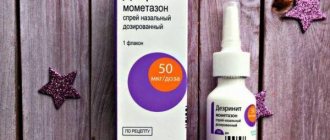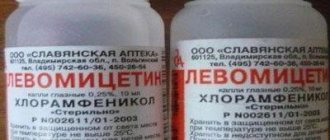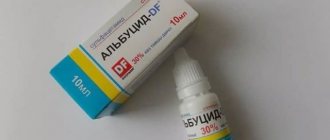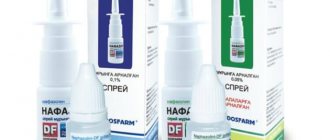Pharmacological properties of the drug Galazolin
Pharmacodynamics. Xylometazoline is an imidazoline derivative that has a sympathomimetic effect and is a direct antagonist of α2-adrenergic receptors. Causes a narrowing of the blood vessels of the nasal mucosa, eliminates its hyperemia and swelling, and reduces exudation. Long-term use of the drug (over 2 weeks) can lead to secondary dilation of blood vessels (rhinitis medicamentosa), which may be caused by inhibition of the release of norepinephrine from nerve endings by excitation of presynaptic α2-adrenergic receptors. Pharmacokinetics. The effect of the drug develops after 5–10 minutes; its effect lasts for 5–6 hours, but vasoconstriction persists for another 8–12 hours. When applied to the mucous membrane, the drug causes local constriction of blood vessels and is practically not absorbed into the bloodstream and has no systemic effect. If a significant amount of xylometazoline enters the digestive tract (mainly possible in children), excessive sedation is noted.
Galazolin for children
In pediatric practice, Galazolin is used locally intranasally from the age of two to six years, 0.05% drops in a dose of one to two drops from one to two times a day, depending on age. It is also in the form of a 0.05% intranasal gel and is used from three to twelve years of age, one to two doses (one to two injections) in each nostril two to three times a day using a dosing device and one dose of the gel contains 50 micrograms xylometazoline.
In childhood, Galazolin is used for rhinitis and sinusitis, and is also included in the therapeutic complex of drugs for the treatment of acute otitis, eustachitis and laryngitis.
It must be remembered that with increased use and/or increasing the dose, adverse reactions may occur in the form of irritation of the mucous membrane, which manifests itself in the form of sneezing, burning, tingling, dryness or hypersecretion, as well as severe swelling of the nasal mucosa, which will only aggravate the symptoms of rhinitis.
In early childhood, the use of vasoconstrictor drugs is not recommended due to the high vulnerability and sensitivity of the mucous membrane of the nasal cavity or paranasal sinuses.
Parents need to know that topical medications can cause an overdose when the dose and frequency of use are increased. Also, an overdose of the drug is possible when taking Galazolin orally - it is possible to swallow the drug in a large dose and there is a high risk of poisoning.
Symptoms of an overdose of adrenergic agonists are frequent vomiting, blurred vision, anxiety, sleep disorders or depressive states, as well as tachycardia, increased blood pressure and heart rhythm disturbances. If these symptoms associated with an overdose of Galazolin occur, the child needs urgent help in a medical facility.
Galazolin price
Galazolin is an over-the-counter drug, and its cost ranges from 35 rubles.
Use of the drug Galazolin
nasal drops 0.05% (1 drop contains 0.025 mg of xylometazoline hydrochloride). For children aged 4 months to 2 years, 1 drop of 0.05% solution is instilled into each nasal passage every 8–12 hours; children aged 2-12 years - 2-3 drops of 0.05% solution in each nasal passage every 8-10 hours. Nasal drops 0.1% (1 drop contains 0.05 mg of xylometazoline hydrochloride). For adults and children over 12 years of age, instill 2-3 drops into each nasal passage every 8-10 hours. The drug in the form of 0.05 and 0.1% nasal gel is applied to the nasal mucosa by quickly pressing the bottle dispenser once. Each time before using the drug, you must remove the nozzle and press the dispenser 3-5 times until the drug (gel) appears. Nasal gel 0.05% (one pump contains 0.05 mg xylometazoline hydrochloride). Children ages 3–12 years: Nasal gel 0.05%: usually apply one pump into each nasal passage every 8–10 hours. Nasal gel 0.1% (one pump contains 0.1 mg xylometazoline hydrochloride). Children over 12 years of age and adults: usually one application in each nasal passage every 8-10 hours is prescribed. The course of treatment is usually 3-5 days and in any case should not exceed 2 weeks.
What do you need to know about the drug?
This medication is an alpha-adrenergic agonist and it relates, in particular, to imidazole derivatives. The use of the drug leads to the manifestation of pronounced vasoconstrictive (vasoconstrictive) and anticongestive (eliminating swelling) effects.
Mechanism of action
When applied topically, there is no absorption (absorption or absorption) of the active substance. At the same time, its concentration in the blood is too low and using modern research methods it is impossible to detect xylometazoline in the body after consuming the drug.
For colds, the use of the medicine leads to easier breathing through the nose, as well as the elimination of swelling and hyperemia literally three to five minutes after instillation or laying. The effect of the medication lasts about 12 hours.
However, if the medication is used for several days, tachyphylaxis develops. This term is used to refer to the manifestation of a specific reaction in the body, in which the therapeutic effect of the drug decreases quite quickly when the drug is used repeatedly. In this regard, long-term use of the product by practitioners is not recommended, since the effect is reduced.
Benefits and price
The drug Galazolin has long received well-deserved popularity. It can be effectively used as prescribed not only by adult patients, but also for diseases of the nasopharynx in children over two years of age. The secret of the drug’s success lies in the following reasons:
Onset of rapid effect. A noticeable result after use occurs quite quickly, within three to five minutes. For some patients, the effect takes a little longer. The result becomes noticeable within 10 minutes.- The spectrum of action of the drug is quite wide. It is used for problems such as sinusitis, rhinitis, and also for otitis media together with other drugs.
- Low cost. The drug is not only high quality, but also inexpensive.
- The medicine contains no ingredients that have an unpleasant odor or taste. This allows the drug to be successfully used for children.
- The product is over-the-counter. To purchase the drug, you do not need to first wait for an appointment with a therapist.
- The small size of the bottle or tube allows you to always have the drug with you.
- The drug has a rather big advantage - a low price. The cost of the medicine in drops is 36 rubles. The price for the gel is higher - 166 rubles.
Components and Forms
Galazolin is produced in different forms and dosages:
- Nasal gel: pediatric (0.05%) and adult (0.01%) dosages. The advantage of the gel is that it moisturizes the nasal passages, thereby not drying out the mucous membrane. The medication in this form does not leak out of the sinuses and does not penetrate the throat.
This makes it very convenient to use. The gel bottle is convenient as it has a dispenser that allows you to spray the product evenly. Many patients call this drug vital. The main component of the medication is xylometazoline. The preparation in the form of a gel also contains the following excipients:
purified water,- sodium hydrogen phosphate (used as food additive E339),
- sodium dihydrogen phosphate (in pharmacology used as a water-retaining substance),
- glycerol (the simplest alcohol),
- disodium salt (antioxidant),
- benzalkonium chloride (antiseptic),
- hydroxyethylcellulose (a substance that imparts viscosity),
- sorbitol (sugar substitute, detoxifying agent).
sodium chloride (known in everyday life as table salt),
Side effects of the drug Galazolin
Locally, in some cases there may be irritation, burning, an unpleasant feeling of dryness of the nasal mucosa, and sneezing. Very rarely, systemic effects occur - headache, drowsiness, weakness, tachycardia, sedation (after overdose). If a very high dose is used or used incorrectly, the drops can be swallowed, which leads to absorption of the active substance into the gastrointestinal tract. Such cases occur mainly in children, with the main side effect being excessive sedation.
Galazolin side effects
With frequent and/or prolonged use - irritation and/or dryness of the nasopharyngeal mucosa, burning and paresthesia of the nasal mucosa, sneezing, hypersecretion of the nasal mucosa.
Rarely - swelling of the nasal mucosa, palpitations, tachycardia, arrhythmias, increased blood pressure, headache, vomiting, insomnia, blurred vision; depression (with long-term use in high doses).
Overdose There have been no cases of drug overdose in adults.
If too large a dose is used or used incorrectly, ingestion of drops and absorption of the active substance from the gastrointestinal tract may occur. Such situations were mainly observed in children. In this case, the main side effect was pronounced sedation.
If the drug is accidentally ingested (more often in children), tachycardia, arrhythmia, increased blood pressure, drowsiness, confusion, respiratory depression or irregular breathing are observed.
Treatment is symptomatic.
Interaction with other drugs Incompatible with MAO inhibitors and tricyclic antidepressants.
Special instructions Before use, it is necessary to clean the nasal passages.
The drug should not be used in patients with chronic or vasomotor rhinitis, as they tend to use the drug for longer than 2 weeks.
Long-term use of the drug (more than 2 weeks) can lead to secondary dilation of blood vessels and subsequently to iatrogenic rhinitis (rhinitis medicamentosa). The cause of this disease is inhibition of the release of norepinephrine from nerve endings through stimulation of presynaptic α2 receptors.
Influence on the ability to drive vehicles and machinery. Does not affect the ability to drive vehicles and maintain moving machinery.
Release form Nasal drops 0.1% - 10 ml in a polyethylene bottle with a built-in dropper and a screw cap or a screw cap with first opening control.
Nasal drops 0.05% - 10 ml in a polyethylene bottle with a built-in dropper and a screw cap or a screw cap with first opening control.
One bottle with instructions for use is placed in a cardboard box.
Photo of a bottle of Galazolin drops 0.05%
Storage conditions Store in a place protected from light at a temperature of 15 to 25 ° C. Keep out of the reach of children.
Shelf life: 4 years. Do not use after the expiration date stated on the packaging.
Photo of the packaging of Galazolin drops 0.05%, where the expiration date is indicated
Conditions for dispensing from pharmacies Dispensed without a prescription
Photo of the packaging of Galazolin drops 0.05%, where the price is indicated
Manufacturer JSC Warsaw Pharmaceutical Plant Polfa st. Karolkowa 22/24, 01-207 Warsaw, Poland
Organization that accepts consumer complaints OJSC Chemical and Pharmaceutical Plant AKRIKHIN 142450, Moscow region, Noginsky district, Staraya Kupavna, st. Kirova, 29 Tel.
Special instructions for the use of the drug Galazolin
the bottle must be used individually; It should not be shared with others for use to prevent the possible spread of infection. The drug in the form of nasal drops should not be used in children under 4 months of age. The drug in the form of a nasal gel should not be used in children under 3 years of age. Use with caution in patients with coronary artery disease, hypertension (arterial hypertension), diabetes mellitus, prostate hypertrophy, hyperthyroidism. The drug can be used during pregnancy only if the expected therapeutic effect for the mother outweighs the potential risk to the fetus. There is no evidence that Galazolin is excreted in breast milk; however, it is not recommended to use the drug during breastfeeding. If the use of the drug is necessary, breastfeeding should be stopped. The drug does not have a negative effect on the ability to drive vehicles or operate potentially dangerous mechanisms.
Galazolin contraindications
- hypersensitivity to the components of the drug;
- atrophic rhinitis;
- angle-closure glaucoma;
- arterial hypertension;
- severe atherosclerosis;
- tachycardia;
- hyperthyroidism;
- pregnancy;
- surgical interventions on the meninges (history);
- children up to 6 years of age (for a 0.1% solution) and up to 2 years of age (for a 0.05% solution);
- simultaneous use of monoamine oxidase inhibitors (MAO) and a period of up to 14 days after the end of their use.
Carefully
- lactation period;
- diabetes;
- angina pectoris III - IV functional class;
- prostatic hyperplasia;
- pheochromocytoma.

